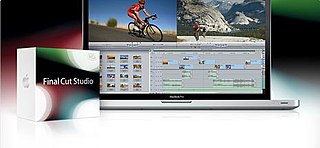
Silicon Graphics, Inc. was an American high-performance computing manufacturer, producing computer hardware and software. Founded in Mountain View, California, in November 1981 by James Clark, its initial market was 3D graphics computer workstations, but its products, strategies and market positions developed significantly over time.

Mac OS X Server is a series of discontinued Unix-like server operating systems developed by Apple Inc. based on macOS. It provided server functionality and system administration tools, and tools to manage both macOS-based computers and iOS-based devices, network services such as a mail transfer agent, AFP and SMB servers, an LDAP server, and a domain name server, as well as server applications including a Web server, database, and calendar server.
Darwin is the core Unix-like operating system of macOS, iOS, watchOS, tvOS, iPadOS, audioOS, visionOS, and bridgeOS. It previously existed as an independent open-source operating system, first released by Apple Inc. in 2000. It is composed of code derived from NeXTSTEP, FreeBSD, other BSD operating systems, Mach, and other free software projects' code, as well as code developed by Apple.

Final Cut Pro is a professional non-linear video-editing application initially developed by Macromedia, and, since 1998, by Apple as part of its pro apps collection. Final Cut Pro allows users to import, edit, and process video footage, and output it to a wide variety of formats.

Motion is a software application produced by Apple Inc. for their macOS operating system. It is used to create and edit motion graphics, titling for video production and film production, and 2D and 3D compositing for visual effects.

Xsan is Apple Inc.'s storage area network (SAN) or clustered file system for macOS. Xsan enables multiple Mac desktop and Xserve systems to access shared block storage over a Fibre Channel network. With the Xsan file system installed, these computers can read and write to the same storage volume at the same time. Xsan is a complete SAN solution that includes the metadata controller software, the file system client software, and integrated setup, management and monitoring tools.
Autodesk Media and Entertainment is a division of Autodesk which offers animation and visual effects products, and was formed by the combination of multiple acquisitions. In 2018, the company began operating as a single operating segment and reporting unit.

Final Cut Studio is a discontinued suite of professional video production and post-production made by Apple for the Mac. The suite competed with Avid Media Composer for the high-end movie production market. It first went on sale in 2005.
Raster graphics editors can be compared by many variables, including availability.
A compositing manager, or compositor, is software that provides applications with an off-screen buffer for each window. The compositing manager composites the window buffers into an image representing the screen and writes the result into the display memory.
3Delight is a 3D computer graphics software that runs on Microsoft Windows, macOS and Linux. Developed by Illumination Research, it is both a photorealistic and NPR path tracing offline renderer based on its NSI API scene description and on Open_Shading_Language for shading. It comes with supported, open source plug-in integrations for several DCC applications, such as Autodesk Maya, Houdini, Cinema4D, Katana, OpenUSD Hydra, and a democratic free license that allows for commercial use. It also provides a fully distributed cloud rendering service called 3Delight Cloud.
Nothing Real L.L.C was a company founded in October 1996 by Allen Edwards and Arnaud Hervas which developed high-end digital effects software for the feature film, broadcast and interactive gaming industries. It was purchased in February 2002 by Apple for its flagship digital effects software, Shake.
Final Cut Server is Apple's discontinued server-based backend for managing Final Cut Studio files and for workflow automation. Based on Proximity's artbox package, Final Cut Server includes media asset management tools with access controls and was designed to catalog any media file type and allow addition of custom metadata to make those files searchable. Final Cut Server runs on macOS, and is accessed through a Java client and QuickTime framework running on Windows and macOS. Apple announced the discontinuation of the software in June 2011, replacing it with Final Cut Pro X.
Realsoft 3D is a modeling and raytracing application created by Realsoft Graphics Oy. Originally called Real 3D, it was developed for the Amiga computer and later also for Linux, Irix, Mac OS X, and Microsoft Windows.
OpenFX (OFX), a.k.a. The OFX Image Effect Plug-in API, is an open standard for 2D visual effects or compositing plug-ins. It allows plug-ins written to the standard to work on any application that supports the standard. The OpenFX standard is owned by The Open Effects Association, and it is released under a 'BSD' open source license. OpenFX was originally designed by Bruno Nicoletti at The Foundry Visionmongers.

Natron is a free and open-source node-based compositing application. It has been influenced by digital compositing software such as Avid Media Illusion, Apple Shake, Blackmagic Fusion, Autodesk Flame and Nuke, from which its user interface and many of its concepts are derived.

DaVinci Resolve is a proprietary color grading, color correction, visual effects, and audio post-production video editing application for macOS, Windows, and Linux, developed by Blackmagic Design. It was originally developed by da Vinci Systems as da Vinci Resolve until 2009, when da Vinci Systems was acquired by Blackmagic Design. In addition to the commercial version of the software, Blackmagic Design also distributes a free edition, with reduced functionality, simply named DaVinci Resolve.







